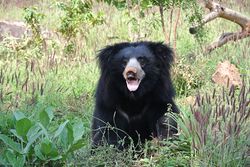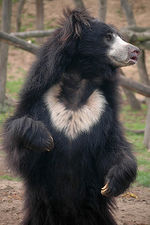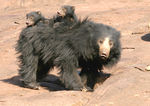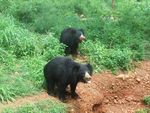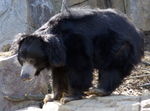Sloth bear
| Sloth bear |
|---|
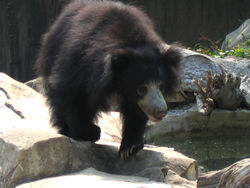
|
| Scientific Classification |
| Binomial Name |
|
melursus ursinus |
| A sloth bear in its natural habitat. |
The Sloth Bear is a species of bear known by the scientific name Melursus ursinus. The Sloth Bear is also known as the Stickney bear or Labiated bear, which means a bear having lips. The Sloth Bear is a nocturnal species that eats mostly insects. They have a lower lip and palate that is perfect for sucking insects. Their claws are sickle-shaped and they have a bushy coat what forms a mane around their face. These bears have been used for entertainment because they are so easily trained. Because of loss of habitat within the Indian continent, and also the poaching of these bears they are on the "vulnerable" list, which is close to being "endangered".[1][2]
Body Design
The Sloth Bear was originally thought to be a member of the Sloth family and was called a Bear Sloth. Later, scientists found that it had more characteristics of the bear family and renamed it the Sloth Bear. The adult male Sloth Bear can weigh up to 200-320 pounds. The female can weigh up to 121-210 pounds. The male sloth bear can grow to 6.25 feet long and 32 inches tall. [3] Sloth bears have long, shaggy coats with longer hair around their neck that make it look like they have a mane. They have rough, dirty, black fur and a short muzzle that is light yellow. Their claws are long and curved, as they are used to dig ants and termites out of the dirt. Their chests have either a pale, dirty-white "Y" or "V" marking. The nostrils of the Sloth Bear can close to protect dirt from getting into their noses. There is also a gap in their teeth so they can suck up their food from the dirt. Their lips are elongated, making them able to make many facial expressions that they use, along with their legs, to make many more gestures than other bears. Their tails are six inches long, longer than any other bear species. Their small ears have long hair, making them appear larger than they actually are.[4]
The Sloth Bear is a reclusive animal. They spend most of their time alone and they are one of the smallest bears. They are shy and don't associate with other bears and even avoid other animals, preferring to be by themselves to eat and sleep. When food is plentiful or in mating season, they travel in pairs. The Sloth Bear is one of the few bear species who carry their young on their back.[5] Sloth bears don't have good hearing because they have tiny ears and they have amazing smelling power. All their toes are webbed and their front legs are pointed inward but claws can get as long as three inches.[6]
Life Cycle
In the wild it is unknown how long the sloth bear lives, but in captivity they can live up to 40 years. When a sloth bear has new cubs, they have strong toes and forelegs. Their eyes don't open for three weeks after they're born. They are full adults when they reach the age 3 or 4. One to three cubs are born each time a mother has babies. The cubs will stay with their mom for two or more years. The number of sloth bears have decreased in the last thirty years by almost fifty percent.[7] In May, June and July the hot season, is when the sloth bears mate. The females give birth from six to seven months after mating. They are born in an underground den. [8]
Sloth Bear are most active at night. They are a busy and noisy bear. When it pulls down branches to get fruit, it snorts and grunts. The way they get insects out of the ground is by sucking them like a vacuum. While they are sucking the insects out, they make a loud sound. If the area where they live is protected, they can come out during the day. They might be small, but if threatened they can use their massive claws as weapons.[9] They can use their huge claws for busting into insect mounds. Sloth bears also eat fruits and flowers. [10] The weight of a new born cub is about 10.5 to 17.5 ounces.[11]
Ecology
The Sloth bear lives in a variety of different places throughout the year including the mainland of India. They live in rain forests, grasslands, thorny woodlands, and wet, tropical regions. They like their land to have boulders with trees and scattered shrubs. For them, the trees provide shelter. Their main threats to survival are poaching, capturing, habitat loss, and conflict with humans.[12] The sloth bear likes to eat ants, fruits, and termites. Right now, they are a lowland species who range from India to Nepal. Sloth Bears avoid contact with humans and will attack if they are disturbed or feel threatened.[13]
The most recent place they are to be known is Bangladesh. Sloth bears have never gone farther than Gujarat. They do not like to be disturbed, especially by humans. Sometimes sloth bears will raid farms. Like, for example, a fruit or peanut farm. [14] Many sloth bears are losing their habitat to humans. They aren't just losing their habitat, they are also losing their food source. It is difficult to get data on the sloth bear since they forge at night.[15]. In the wild there are only about 7 thousand to 10 thousand left. The males average range is about 5 miles and the females is about 3 square miles.[16]
Other Topic
This is about how Sloth Bears act in captivity. At Seattle's Woodland Park Zoo Sloth Bear Exhibit, there are three bears. Two females, one the mother and the other the daughter are separated from one male. The exhibit looks a lot like the bear's natural habitat with many trees, rocks, bushes and a cave for sleeping. During my two visits to the exhibit, they were all asleep the entire time. The male bear was much larger than the two females. The enclosure was very large and had enough room for the bears to run and play. They didn't seem to be bothered by humans watching them. The males exhibit was larger than the females, with more and taller trees and bushes.
References
- ↑ Youth, Howard. Sloth Bear National Zoo. Web. 1999 (date of publication)
- ↑ The World Wildlife Fund Species Directory 2016". (last-modified 2016)
- ↑ http://www.zoo.org/
- ↑ https://nationalzoo.si.edu/Animals/AsiaTrail/SlothBears/factsheet.cfm
- ↑ Youth, Howardhttp://dilmahconservation.org/animal_profiles/sri-lankan-sloth-bear/
- ↑ http://www.bearsoftheworld.net/sloth_bears.asp
- ↑ http://www.zoo.org/
- ↑ Youth, Howardhttps://nationalzoo.si.edu/Animals/AsiaTrail/SlothBears/factsheet.cfm
- ↑ https://nationalzoo.si.edu/Animals/AsiaTrail/SlothBears/factsheet.cfm
- ↑ http://animals.nationalgeographic.com/animals/mammals/sloth-bear/
- ↑ http://www.bearsoftheworld.net/sloth_bears.asp
- ↑ http://www.zoo.org/
- ↑ http://www.iucnredlist.org
- ↑ http://www.iucnredlist.org/details/13143/0
- ↑ http://www.bearbiology.com/fileadmin/tpl/Downloads/URSUS/Vol_15_2/Bargali_Akhtar_15_2_.pdf
- ↑ http://www.bearsoftheworld.net/sloth_bears.asp
